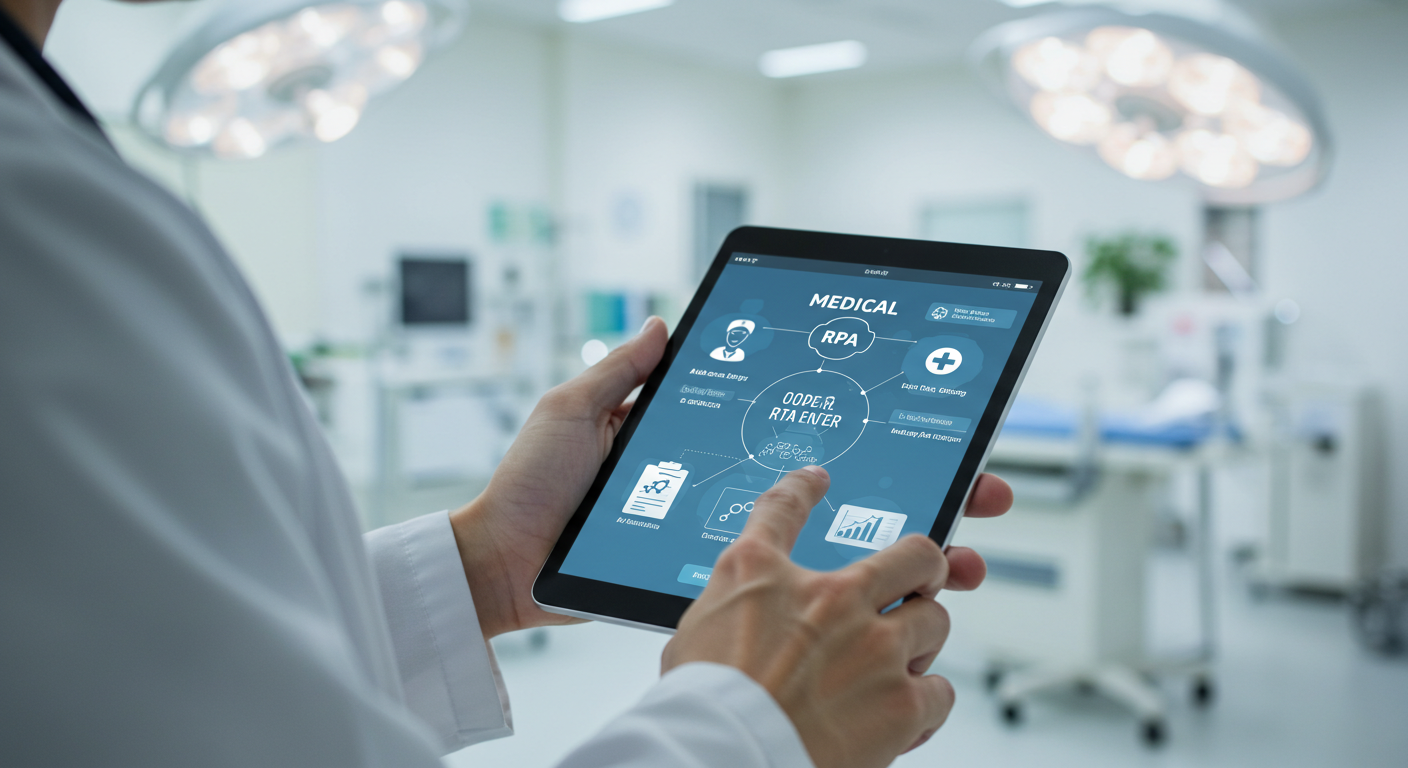RPA for Healthcare: How Automation Is Redefining Patient Care in 2025
Picture this: what happens when cutting-edge robots meet the chaos of healthcare? The answer might surprise you. While doctors and nurses fight burnout, administrators drown in paperwork, and patients wait longer than ever for care, a digital revolution quietly transforms medical facilities worldwide.
Healthcare organizations generate mind-boggling amounts of data daily. From patient records to insurance claims, manual pro cessing devours countless hours that could otherwise support direct patient care. Enter RPA for healthcare—a game-changing technology that’s not just improving efficiency but completely reshaping how medical institutions operate in ways nobody saw coming just a few years ago.
When Digital Workers Clock In: RPA's Medical Breakthrough
RPA for healthcare operates through digital workers that mimic human actions within existing systems. These software bots click, type, and navigate through applications exactly like humans do—except they work 24/7 without coffee breaks. Unlike traditional IT solutions demanding expensive system overhauls, RPA integrates seamlessly with the legacy healthcare systems that many organizations still depend on.
The technology proves especially valuable because medical facilities handle enormous volumes of structured data. Patient registration forms follow predictable patterns. Insurance verification documents contain standard fields. Billing records maintain consistent formats. RPA systems learn these patterns and replicate them with remarkable precision.
A single bot can juggle multiple tasks simultaneously across different platforms. It extracts patient information from one system, verifies insurance coverage in another, and updates billing records in a third—all within minutes. This cross-platform functionality eliminates the need for staff to toggle between applications, reducing both processing time and error rates.

The $22.56 Billion Healthcare Automation Revolution
The numbers tell a compelling story. The global robotic process automation in healthcare market size is estimated at USD 2.22 billion in 2024 and is anticipated to reach around USD 22.56 billion by 2034, expanding at a CAGR of 26.10% between 2024 and 2034. This explosive growth reflects healthcare’s urgent need for operational efficiency.
RPA services for healthcare have evolved far beyond simple data entry tasks. Modern implementations encompass complex workflows spanning entire patient journeys. Healthcare providers increasingly recognize that these services can address their most pressing operational challenges while delivering measurable returns on investment.
Patient data management represents one of the most impactful applications. Healthcare systems often struggle with fragmented information spread across multiple databases. RPA bots consolidate this data, ensuring patient records remain accurate and up-to-date across all systems. This consolidation proves especially valuable during patient transfers between departments or facilities, where information gaps can compromise care quality.
APIs: The Secret Weapon Behind Healthcare Automation
Application Programming Interfaces serve as crucial bridges that amplify RPA’s capabilities in healthcare settings. These connections allow RPA systems to communicate directly with various software applications, creating more sophisticated automation workflows. When RPA combines with API functionality, healthcare organizations achieve deeper integration across their technology stack.
APIs enable real-time data access from multiple sources simultaneously. During patient discharge, an RPA bot can use APIs to pull current medication lists, retrieve insurance information, and access scheduling systems to book follow-up appointments. This comprehensive approach ensures discharge processes remain both thorough and efficient.
The combination also supports more dynamic decision-making within automated workflows. Rather than following rigid paths, bots adapt their actions based on real-time information received through API connections. This flexibility proves invaluable in healthcare environments where patient needs and circumstances change rapidly.
Real-World Impact: Where Automation Meets Medicine
Healthcare automation through RPA transforms daily operations in ways that extend far beyond simple time savings. The technology creates more reliable, consistent workflows while reducing operational friction throughout healthcare organizations.
Administrative Revolution in Action
RPA for healthcare transforms administrative processes by handling routine tasks with unmatched speed and precision. The impact extends beyond simple efficiency gains—automated systems create smoother operational workflows that reduce friction throughout healthcare organizations.
Appointment scheduling exemplifies this transformation. Automated systems access provider calendars, patient preferences, and insurance requirements to optimize booking processes. These systems manage cancellations and rescheduling requests without human intervention, ensuring optimal utilization of provider time slots while minimizing patient wait times.
Patient registration processes benefit enormously from automation:
- Pre-population of forms using existing patient data
- Real-time insurance coverage verification
- Automatic flagging of potential issues before patient arrival
- Streamlined check-in processes that reduce delays
These improvements create ripple effects throughout healthcare facilities, reducing stress on staff and improving patient satisfaction scores.
Revenue Cycle Management Gets a Digital Makeover
Medical billing represents one of healthcare’s most complex administrative challenges. Multiple steps, various stakeholders, and strict regulatory requirements create a maze of potential errors and delays. RPA services for the healthcare industry revenue cycle management address these complexities with remarkable effectiveness.
Nearly 70% of respondents reported achieving full ROI on RPA investments within 12 to 18 months of deployment, according to recent research. This rapid return on investment reflects automation’s immediate impact on billing accuracy and processing speed.
Automated systems excel at ensuring billing accuracy from the start:
- Cross-reference procedure codes with patient records
- Verify insurance coverage before claim submission
- Check for potential billing errors and inconsistencies
- Flag unusual charges or patterns for manual review
This front-end accuracy dramatically reduces claim denials and associated costs of reprocessing rejected submissions.
Electronic Health Records: From Chaos to Order
Electronic Health Records store vast amounts of patient information, but managing this data often proves challenging for healthcare staff. RPA for healthcare addresses these challenges by automating data entry, ensuring consistency across platforms, and maintaining data integrity throughout patient care episodes.
Data migration between EHR systems represents a particularly complex challenge that RPA handles exceptionally well. When healthcare organizations upgrade systems or merge with other facilities, automated processes transfer patient records accurately and completely. This capability eliminates the risk of data loss during transitions while ensuring continuity of patient care.
Compliance monitoring becomes more reliable through automated systems that track data access, maintain audit trails, and generate compliance reports. These capabilities prove especially valuable for HIPAA compliance, where healthcare organizations must demonstrate careful handling of patient information.
The Human Cost: Why Healthcare Desperately Needs Automation
Healthcare faces a crisis that automation can help solve. The statistics paint a sobering picture of an industry under severe strain.
The Medical Error Epidemic
Medication errors are among the most common medical errors, harming at least 1.5 million people every year. The extra medical costs of treating drug-related injuries occurring in hospitals alone are at least $3.5 billion a year. These staggering numbers represent real human suffering and economic burden that automation can help reduce.
Medical errors occur for various reasons, but many stem from preventable administrative mistakes. RPA for healthcare directly addresses several common error sources:
- Data Entry Mistakes: Manual entry of patient information, medication orders, and treatment plans creates numerous opportunities for errors. Automated systems eliminate these transcription mistakes by pulling information directly from source systems.
- Communication Failures: Poor information flow between departments and systems contributes to medical errors. RPA ensures consistent data sharing across platforms, reducing miscommunication risks.
- Process Inconsistencies: Manual processes vary depending on who performs them and when. Automated workflows follow identical steps every time, creating predictable, reliable outcomes.
Staff Burnout Reaches Critical Levels
Healthcare workers face unprecedented levels of stress and burnout. Administrative tasks consume valuable time that could otherwise be used for direct patient care. In the United States alone, UiPath customers used automation to take on over 2 billion hours of burnout-inducing administrative tasks so healthcare workers can focus on what matters most.
The benefits of RPA technology for healthcare extend beyond operational efficiency to include improved staff satisfaction and retention. When automation handles repetitive tasks, healthcare professionals can redirect their energy toward meaningful patient interactions and clinical decision-making.
Staff members report higher job satisfaction when freed from mundane administrative duties. This improved morale translates into better patient care and reduced turnover rates, creating a positive cycle that benefits everyone in the healthcare ecosystem.
Patient Experience Under Pressure
Twenty-one percent of adults report having personally experienced a medical error, according to nationwide survey data. These experiences erode patient confidence in healthcare systems and create lasting impacts on health outcomes.
RPA for healthcare directly enhances patient experiences by:
- Reducing wait times through streamlined processes
- Improving communication through automated updates
- Ensuring accurate information transfer between providers
- Minimizing administrative errors that affect care
Automated appointment reminders and follow-up communications help patients stay engaged with their care plans. RPA systems send personalized messages based on specific patient needs, treatment protocols, and provider preferences, improving appointment attendance rates and treatment adherence.

Market Momentum: The Numbers Don't Lie
The healthcare automation market shows explosive growth driven by urgent operational needs and proven results.
Adoption Rates Accelerate Across Healthcare
In the healthcare industry, RPA adoption stands at 10%, indicating a growing recognition of its potential to streamline administrative and operational processes. While this percentage might seem modest, it represents significant growth momentum in a traditionally conservative industry.
Adoption rates in healthcare are expected to grow by 35% by 2025, reflecting increased confidence in automation technologies and their proven benefits. Early adopters report substantial improvements in operational efficiency, cost reduction, and staff satisfaction.
Regional variations show different adoption patterns:
- North America leads with advanced IT infrastructure and regulatory support
- Europe follows with a strong emphasis on standardization and compliance
- Asia-Pacific shows rapid growth driven by digital transformation initiatives
ROI That Actually Matters
Healthcare organizations demand clear evidence that technology investments deliver measurable returns. RPA provides exactly that evidence through quantifiable improvements across multiple metrics.
Through the incorporation of robotic process automation (RPA) in healthcare claims management, Care1st Health Plan Arizona significantly shortened the time required to process individual claims from 20 seconds to a mere 3 seconds. This dramatic improvement demonstrates automation’s immediate impact on processing efficiency.
Financial benefits extend beyond simple time savings:
- Reduced labor costs for routine administrative tasks
- Decreased error rates leading to fewer claim denials
- Improved cash flow through faster payment processing
- Lower compliance costs through automated documentation
The Competitive Advantage Factor
RPA services for healthcare industry leaders recognize automation as a competitive differentiator rather than just a cost-saving measure. Organizations that implement comprehensive automation strategies position themselves for long-term success in an increasingly complex healthcare environment.
The Future is Automated
The future of healthcare depends on organizations’ ability to balance human expertise with technological capabilities. RPA for healthcare represents a powerful tool for achieving this balance, enabling healthcare professionals to focus on direct patient care while automated systems handle routine administrative tasks.
Healthcare automation through RPA extends beyond operational efficiency to encompass improved patient outcomes, enhanced staff satisfaction, and more sustainable business models. Organizations that master this integration position themselves to deliver high-quality care in an era of increasing complexity and resource constraints.
As we advance through 2025 and beyond, RPA will undoubtedly play an increasingly central role in defining healthcare delivery’s future. The benefits of RPA technology for healthcare create compelling business cases for adoption, while the human costs of maintaining status quo operations become increasingly unsustainable.
Healthcare organizations that embrace automation today build foundations for tomorrow’s success, creating systems that can adapt, scale, and thrive in an ever-changing environment.